How did the Colorado Avalanche transform themselves from one of the league’s worst teams, with 48 points in 2016-17, to contending for the top seed in the Western Conference in three short years?
Changes. Lots and lots of changes. And it all started with current general manager Joe Sakic.
The Perfect Storm – 2016-17 season
Once upon a time, in an Avalanche corporate office far, far away, a frustrated front office hired two former stars to help re-establish the hockey club as a contender. In the spring of 2013, the powers that be expanded Sakic’s role (he had spent the previous two years with the team in an advisory capacity) while also hiring fiery former All-Star goaltender Patrick Roy to coach the team. Part of the arrangement included an unusual deal – both had the power to determine personnel.
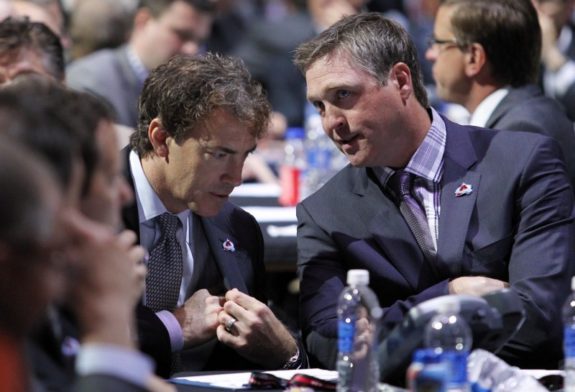
Flash forward to the disappointing end of the 2016 season. While fighting for a playoff spot, the front office traded for four players at the trade deadline to stock the cupboards. However, key injuries decimated the team’s chances for a playoff berth and they finished out of the hunt, seventh in their division.
Determined to shore up their young talent, the Avalanche added a number of veterans over the summer. Roy favored a big body heavy game to complement his skilled players and that’s what the team picked up. Eleven of them. Meanwhile, the team failed to extend the two better players they acquired at the trade deadline and lost eight players to free agency.
Related: Quebec Nordiques – A History of Beer, Brawls, and Van Halen
Then, Roy abruptly quit on Aug. 11, 2016. He complained he didn’t have enough say in personnel decisions. Whether he was angry about players who were signed or players who were traded away remains unclear. Either way, the Avalanche had to find a head coach – and fast. Roy resigned one month before rookies reported to camp.
Teams already snatched up the top head-coaching candidates earlier in the spring and summer. Sakic gambled and hired rookie coach Jared Bednar on Aug. 25. Bednar had success at both the AHL and ECHL level, winning championships, but had never been on the bench for an NHL club. The window was so short, he didn’t even have time to hire his own assistants. The team went forward with the rest of the staff Roy had.
Sakic announced the team would be shifting towards a younger and faster mode of playing. Unfortunately, they had very few of those kinds of players on the team.
To make matters worse, veteran defenseman Erik Johnson missed half the season with a broken leg and starting goaltender Semyon Varlamov underwent season-ending surgery, leaving backup Calvin Pickard to take the lion’s share of starts. As if that wasn’t enough, it later leaked out forward Matt Duchene requested a trade, not wanting to be part of the rebuild. So add “toxic locker room” to the list of things that went wrong.

It was the perfect storm. A new coach, a new vision, key injuries, a disgruntled star, and new players specifically selected for the old plan. That’s how the Avalanche earned a mere 48 points. Dead last in the NHL.
There was one silver lining. The Avalanche called up two of their young forwards – J.T. Compher and Tyson Jost – near the end of the season, plucked winger Matt Nieto and defenseman Mark Barberio off waivers and traded for forward Sven Andrighetto. They breathed some life into a club and a fanbase desperate for hope.
Don’t worry. This isn’t a tale of doom and gloom. The good is coming. Sakic and company got to work bringing everything into alignment with the new direction.
Draft Changes – Improved Scouting
The Avalanche had already vastly improved their scouting. They’d picked up two valuable first-rounders in the previous two draft classes – Jost in 2016 and speedy wing Mikko Rantanen in 2015.
Finishing dead last in the league helped as well. The lottery ball didn’t drop their way in the 2017 draft, falling to the fourth selection despite their disastrous season. But that pick led to the acquisition of defenseman Cale Makar. The team also selected another promising defenseman at the top of the second round – Conor Timmins.
Makar showed his skills in the 2019 playoffs, after winning the Hobey Baker Award and losing in the NCAA Championship Game. He could prove to be a generational player, as he currently sits in second place for rookie scoring despite missing games to injuries. He’s in contention for the Calder Trophy as Rookie of the Year and he already broke or tied several Avalanche records for scoring by defensemen in the 2019-20 season.

Timmins may not be the power scoring threat of Makar but he plays a solid defensive game. His trajectory stalled when he missed a full season recovering from concussion symptoms. The Avalanche believe in the prospect and he’s likely to make a push for the club’s starting roster next season.
Subsequent drafts led to other promising acquisitions. Forward Martin Kaut, goaltender Justus Annunen, defenseman Bowen Byram and forward Alex Newhook all sit atop the list.
Related: Coach Bednar Continues to Improve with Avalanche
Kaut proved ready for his recent call-up and should be considered a favorite to make the roster next season. Annunen is making a name for himself and proved solid at the World Juniors Championship. Byram was named the WHL’s Player of the Month for February (it’s his third such honor) as he’s racked up 48 points in 48 games. And Newhook was just named both the National Player AND Rookie of the Month for his stellar season at Boston College.
It is a far cry from the days of picking Conner Bleackley and Mitchell Heard in the top rounds.
Player Changes – Draft, Trades, and More
Sakic heard Duchene’s trade request but held onto the star until he received an offer that met his expectations. He finally found a deal worth taking, sending Duchene to the Ottawa Senators in exchange for talented defenseman Samuel Girard, forward prospect Shane Bowers, and oft-injured forward Vladislav Kamenev. But they also got draft picks that made an impact.
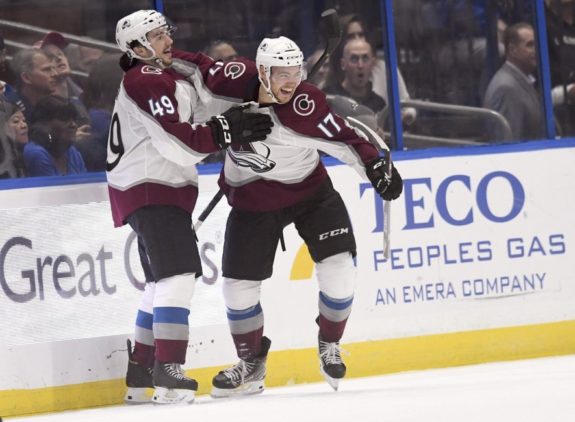
Two of the picks led to Byram’s and Annunen’s draft selections. The other one allowed the Avalanche to trade away one of their picks to acquire goaltender Philipp Grubauer. Perhaps the best gift of all, after the trade, Nathan MacKinnon elevated his game, becoming a Hart Trophy candidate and a well-deserved All-Star.
But the Duchene trade wasn’t the only change. Five players remain on the current roster who were starters for the dismal season while two others play for the team’s AHL affiliate. The dramatic shift encompasses 19 players on this season’s roster who didn’t start in that disastrous 48-point season. Two-thirds of the current team never suffered through Bednar’s first year or the frustrations of the 2016-17 season. That’s a lot of fresh blood.
Related: Avalanche’s MacKinnon Cool but Team Continues to Stay Hot
The roster changes also moved the Avalanche from one of the oldest teams in the NHL to one of the youngest. Gone are the long contracts to aging NHL veterans. Instead, the front office weaponized their cap space to buy out players that no longer fit their vision and acquired other assets.
One other key change – Sakic has become proactive in his moves. Last summer, he traded Barrie for a much needed second-line center when it became apparent the defenseman would want more money than the Avalanche would spend. Even the trade for Grubauer was a pre-emptive deal as Jonathan Bernier said he wanted to test the free-agent market before signing with the club. The team learned their lesson from Paul Stastny’s unexpected departure.
They have also managed to find good fits from other teams. Sakic traded defenseman Chris Bigras for Ryan Graves, who’s become a powerhouse this season. The acquisition of forwards Valeri Nichushkin and Vladimir Namestnikov reveals the NHL scouts are finding quality players who benefit from the Avalanche’s style of play, without overpaying for them.
Coaching Changes
Since Bednar survived his first season as an NHL coach in 2016-17, the team made some other interesting moves. Most of the existing infrastructure left the following summer.
Assistant coaches Tim Army, Dave Farrish, and Francois Allaire moved on. Bednar added Ray Bennett as an assistant coach and Jussi Parkkila as the goaltending coach. Nolan Pratt, who had been hired the previous summer before Bednar joined the team, stayed on as did Brett Heimlich, who moved to the role of video coach.
In the 2017-18 season, Bednar finally had a group of like-minded assistants and they devised systems to work with the players. Young, fast and skilled became the focus. Bednar doubled down on conditioning, making bag skates a key part of training camp and even went so far as requiring players returning from injury to do their skate when healthy, with teammates cheering them on.
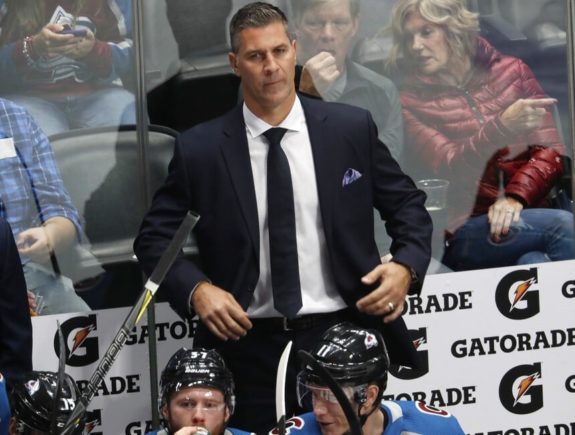
But the avalanche of changes didn’t stop with the NHL club. The team announced it would switch its AHL affiliate the following year, moving from the San Antonio Rampage to promoting the ECHL Colorado Eagles to the AHL.
There were struggles as the Avalanche and St. Louis Blues shared the Rampage that final year. But the Eagles went on to win their second Kelly Cup before rising to the AHL, bringing their successful history with them.
The Avalanche/Eagles worked together to bring in Greg Cronin as the team’s new head coach while keeping most of the Eagles staff. Cronin had both NHL and AHL experience and seemed a good fit to fill the gaps.
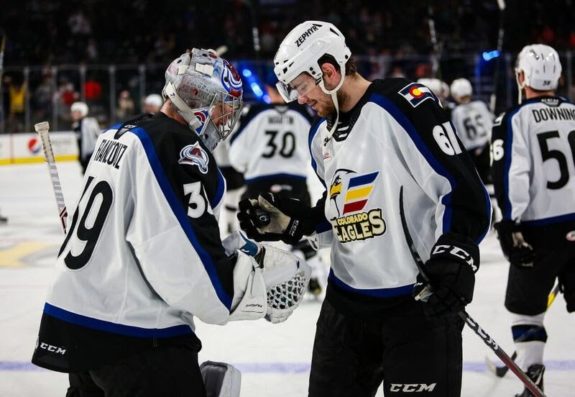
The Eagles made it to the playoffs in their first AHL season, something the Rampage hadn’t managed in their three previous seasons. Their location also helped. The Eagles facility sits an hour north of the Pepsi Center, making player moves easier. The AHL team also implemented systems similar to the Avalanche which facilitated the ease of call-ups, with the Eagles players able to slot in more effectively into the Avalanche lineup.
The Eagles currently sit second in their division while having played 52 games. They rank fourth in their conference. That’s a huge improvement from the last place Rampage.
Team Results – The Difference
All the changing parts built to where the Avalanche currently sit. With 66 games under their belt, the team sits two points behind the Blues and six points ahead of the Dallas Stars, with 88 points on the record books. They own a game in hand on both clubs. The club sits 13 points ahead of the nearest wild card team.
Consider the changes.
In 2016-17, for the entire season, their statistics were atrocious. They were dead last in the following categories:
- 48 points for the season
- 21 regulation and overtime wins (ROW)
- Goal differential of minus-112
- 166 goals scored
- 278 goals allowed
- Tied for last with the fewest overtime points
- Away record of 9-30-2
- Home record of 13-26-2
Compare that to their rankings 66 games into this season, with 16 remaining contests.
- 88 points – second in the Western Conference, fourth in the league
- 39 ROW – first in the Conference, third in the league
- Goal differential of plus-49 – first in the Conference, third in the league
- 226 goals scored – first in the Conference, fifth in the league
- 177 goals allowed – second-fewest in the Conference, third in the league
- 8 overtime points – tied for second in the Conference, ninth in the league
- Road record of 23-9-2 – first in the Conference, first in the league
- Home record of 17-9-6 – sixth in the Conference, 16th in the league
In this year’s new category and tie-breaker – regulation wins – the Avalanche lead their conference with 36 regulation wins and rank second in the league. What a difference three years make.
In case anyone thought this season was easy, the Avalanche have lost 195 man-games to injury. The injury bug has arguably been the team’s biggest foe. They aren’t losing fourth line players, either. Currently, seven starters are off the roster because they are banged up – Rantanen, Makar, Nazem Kadri, Andre Burakovsky, Matt Calvert, Philipp Grubauer, and Colin Wilson.
Consider this – backup goaltender Pavel Francouz has more wins than starter Grubauer, MacKinnon kept scoring without Gabriel Landeskog and Rantanen, and Makar’s still in contention for the Calder despite missing nine more games than the current rookie point leader.
None of their current lineup played together at the start of the season. AHL players are slotting in and playing crucial roles. The Avalanche are miles ahead of where they were during the 48-point season.
Staring Down the Playoffs
Sakic and Bednar deserve all the credit for building a team that’s competing for the top spot in the conference, despite all the injuries. The Avalanche are competitive, their scoring prowess makes them dangerous, and their defense developed to shut down opponents. They are a deep club.
They also have two seasons of playoff experience which built a hunger for more. The team is poised to make noise in the postseason. All they need is for the injury bug to leave town, on a fast train to nowhere.
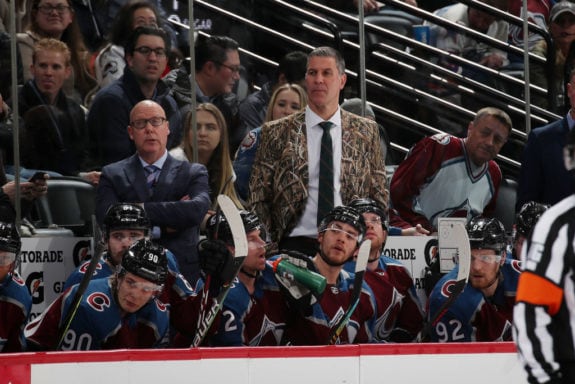
The tale isn’t yet over. The Avalanche worked hard to earn their happy ending and now they have the chance to press for the Stanley Cup. One thing they already accomplished – they are no longer the laughing stock of the NHL. They deserve to be feared.